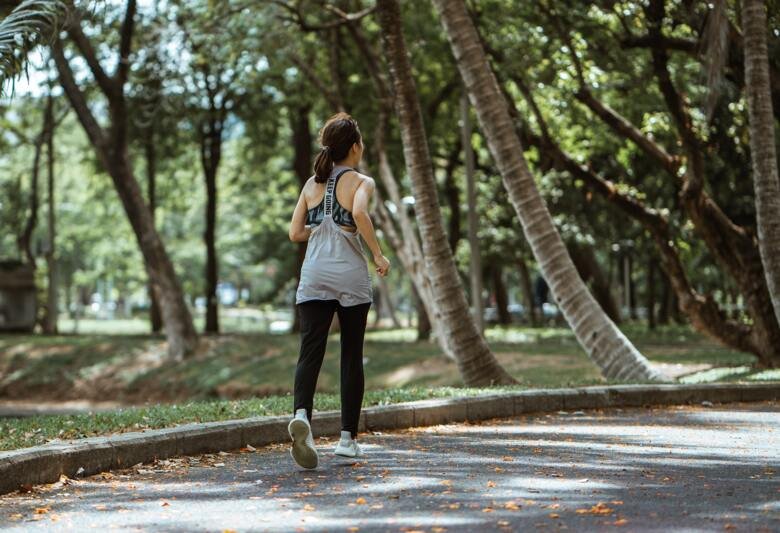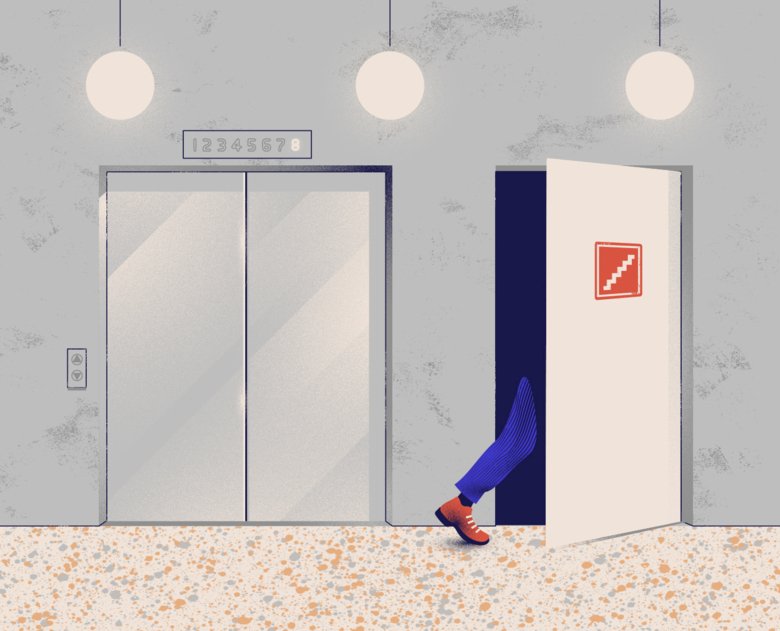Why each step counts – curious about everyday activity
The pandemic has changed our habits, but we have continued to be active/on the move. This is a good thing, because it is hard to find anything that promotes health as much as physical activity. Today we know more about why this is so.
Text: Anders Nilsson, first published in Swedish in the magazine Medicinsk Vetenskap no 2/2021.
There are species of animals that have evolved to remain still for a very long time, but humans do not belong to that kind of species. We are designed to be in motion. Our physical and mental health depends on our being able to move about to a sufficient extent.

"All the organs in the body are positively affected by the movements we make," says Maria Hagströmer, Professor of Physiotherapy at the Department of Neurobiology, Healthcare Sciences and Society, Karolinska Institutet. She begins by listing the reliable research evidence that is currently available: exercise prevents premature death, most cardiovascular diseases, type-2 diabetes, metabolic syndrome, overweight and obesity, at least eight forms of cancer, dementia and mental illness such as depression, anxiety and stress. Sleep, cognitive function and quality of life have been improved.
We have known that we benefit from being physically active for a long time. But in recent decades, research has acquired a more detailed image of this relationship – such as what kind of and how much motion we need, and what is really happening in our cells as we move.
"In the 1990s, when I started my research, the discussion was largely about the importance of exercising a specific number of times a week," says Maria Hagströmer. Now we know that movement does not have to be very intense at all to be beneficial for health. All the motion in everyday life matters – also the most modest kind, like getting up from your desk and going for a walk to the coffee machine.
Measuring activity
One reason for our modified view is that technological developments have made it possible to measure how much people move about so that we do not have to ask them about things like the number of workouts they do or how many hours a day they are seated/sedentary.
"My colleagues and I were among the first in the world when we made our first measurements with motion meters in 1998," says Maria Hagströmer. One thing we have discovered is that it is not possible to trust the responses people provide in surveys. Some may exaggerate how much they exercise, but above all, most of us grossly underestimate how much of the day we spend sitting still. People may answer two or three hours when in actuality it is nine or ten.
Mats Hallgren, a researcher at Karolinska Institutet's Department of Global Public Health, studies how motion affects our mental health. He, too, sees how the focus of research has begun to move from regular exercise to motion in everyday life.

"What current research provides most support for is that a minimum of three workouts a week is good for mental health and even has a positive effect on such things as mild to moderate depression. But this does not necessarily imply those three exercise sessions constitute the optimal choice, but simply that there has been a lot of research done where the researchers have chosen three training sessions a week as a measure. Research is currently being broadened to identify the nuances. What we have seen so far suggests that daily exercises with slightly less exertion, such as taking walks, may be just as good for mental health as more intense exercise. I think we will know a lot more about this In a few years.
WHO (the World Health Organisation) publishes recommendations about physical activity, which subsequently becomes the starting point for Swedish recommendations. These are formulated by the Swedish Professional Associations for Physical Activity (YFA) and are adopted by the Swedish Society of Medicine. Maria Hagströmer is one of the researchers involved in this work.
Updated recommendations
"We have just updated the Swedish recommendations," she says. Adults should be physically active for 150-300 minutes per week if there is moderate intensity, and for 75-150 minutes per week if the intensity is high. Moderate intensity is when your heart rate increases and there is some shortness of breath, but you are still able to speak – e.g., a brisk walk. High intensity, for example, is running and other forms of activity where you become so out of breath that it is difficult to talk at the same time.
Naturally, alternating between exercises of different intensity is an excellent strategy,” she stresses. The rule of thumb is that two minutes of exercise at moderate intensity corresponds to one minute of high intensity exercise.
“The fact that if you double the time, moderate intensity will provide the same number of health benefits is an important discovery. This means that there are many ways of reaching one’s goal, and that as an individual you have a better chance of finding something that suits you.
The new recommendations also emphasise that anyone with a disease or disability should be as active as his/her condition allows.
“Reduce the intensity even further if necessary, or switch to another form of activity," says Maria Hagströmer. There are a lot of tips and advice about physical activity for different disabilities. If need be, get help from a physiotherapist.
You do not have to reach the recommended goal in order achieve positive health benefits,” she stresses. The greatest effect on health is seen in those who go from being very inactive to being a little more active.
Restrict sedentary behaviour
The new recommendations also include a call to restrict sedentary behaviour.
"It is becoming clear that being sedentary for large parts of the day constitute a health risk," says Maria Hagströmer. One reason is that blood circulation decreases, affecting blood sugar and blood fats. Getting up, if only to go for a walk down the corridor, will help to improve your values. Therefore, it is important for anyone who has a sedentary job to take breaks.
It would have been nice to be able to give definite information on how frequent the breaks should be or how much you may sit during a day,” she says, “but the research has not progressed that far yet.” Recommendations should not be based on guesswork. However, we can provide some general tips:
“Utilise natural interruptions at work to take breaks from sitting down. Generally speaking is a good thing. Use the possibilities that are available to vary and reduce sitting, e.g., height-adjustable desks and walking meetings."
Is mental health also affected by sedentary behaviour? Mats Hallgren and his colleagues have studied this and their conclusion is that it is the context determines this. Adults who spend more than half their free time are more prone to depression and anxiety but sitting a lot in their job does not seem to adversely affect their psyche. The interpretation by the researchers is that brain activity is the cause of the difference. At work, the brain often works at full capacity while sitting, but at home sitting means greater passivity for both the body and the brain.
"We do not know about the mechanisms yet," Hallgren says. It could be due to the fact that the blood flow to the brain is greater when it is active.

How good are we at moving enough?
"About half of all adults spend more than nine hours a day sitting," says Maria Hagströmer. And about half of all adults move as much as the stated recommendations. When asked, 70% say they do, but when we measure this it ends up at around 50%. For a long time, it was believed that men are physically more active than women, but, in fact, this is because men pile it on more when they report. When we measure movement, both sexes move just as much.
How has a year with the pandemic affected our mobility?
"The research that exists in this area paints a rather sprawling picture," says Maria Hagströmer. We can probably say for sure that regular exercising has decreased, but, at the same time, in Sweden we see that everyday activity has increased: people take a walk at lunch time or go on a hike on the Sörmland Trail at the weekend. And there has been a huge boost for Sofia's workout on TV.
She says that data collected from mobile phone pedometers show how mobility decreased significantly in many other countries in the spring of 2020.
“In some countries, like Spain, it decreased by about 40 percent. But in Sweden there was no big change. Most likely, one reason is that we have not had a hard lockdown here.
But an average for the country does not say everything,” she adds.
"The pandemic hits certain groups harder, and this also true in this area. Those who have their own passion for mobility will find new ways to keep doing this. But there is also a group that does get around to it and may find it challenging. If you rely on your daily walk to work to get exercise and then transition to working from home – well, that's not a good thing.”
The importance of everyday activity
Well, what happens in our body when we move around? How can physical activity be beneficial in so many ways? Not all mechanisms have been mapped yet, but we can sketch an overall picture and this contains a wide range of influences. The most obvious thing is that the parts of our body that are directly affected by physical activity – such as lungs, bone structure, heart and other muscles – get exercise and are strengthened. Other health benefits come from physical activity driving metabolism thereby affecting the ill health associated with metabolism – such as obesity, metabolic syndrome and type 2 diabetes.
And then what? Why is physical activity beneficial for everything from our immune system to the brain? This is largely due to the fact that many substances that perform important tasks in your body form in your muscles as they work and subsequently spread throughout your body. A study published in the scientific journal Cell a few years ago showed that a training session led to changes in levels of nearly 10,000 different substances in the blood. Among these are many substances that have important functions in the body: stimulative, analgesic, anti-inflammatory and restorative.
In addition to these biological factors, there are also other reasons why we feel good about being in motion," Mats Hallgren points out. Exercise can also contribute to things like better self-esteem, an increased experience of control, environmental change as well as distracting from everyday worries.

During the 21st century, more attention has been paid to the fact that motion not only prevents ill health but is also often an effective treatment in the event of illness. In Sweden, the concept of Physical Activity on Prescription, far, was introduced in 2001 and two years later the handbook FYSS, Physical Activity in Disease Prevention and Disease Treatment was published. Maria Hagströmer is one of the editors of the book.
“We are now putting the finishing touches to the fourth edition of FYSS, scheduled for release in August 2021. The number of diagnoses has grown to 34, from osteoarthritis to obesity,” she says.
FYSS has also attracted international attention and is now being translated for use in nine EU countries. It is already available in English, Norwegian and Vietnamese. In some cases, physical activity can be an adequate alternative to medicines for both physical disease and mental illness. In other cases, it is a valuable complement.
Physical activity as a treatment
"When physical activity, pharmaceuticals and therapy are compared as treatment for mild to moderate depression, all three options have turned out to be almost equally effective," says Mats Hallgren. Physical activity has also proven to be an effective means of treatment for mild to moderate anxiety. In the case of psychosis, the picture is a little more complex,” he explains. Hallucinations and other so-called positive symptoms do not seem to be affected, but physical activity improves cognition, i.e. The ability to think and reason, which gives the patient better prerequisites to organise their life and to live a normal life.
Mats Hallgren points out that there is also a connection in the other direction: mental illness causes physical inactivity.
"This is another reason why physical activity in the treatment of mental illness is important. Those who suffer often become so physically inactive that this leads to physical diseases - this is one reason why long-term mental illness shortens life expectancy by nearly a decade,” he says.
Finally: not all animal species have to move very much to feel good. Why is the well-being of humans so dependent on daily muscular effort?
"If you go back a few thousands of years, our existence consisted of us roaming the savannah looking for food," says Mats Hallgren. Motion was a prerequisite for survival, these are the conditions that evolution has designed us for. Motion is a part of our natural behaviour. In this light, it is not strange, but rather logical that motion and health are so closely linked to humans.
 Photo: Gustaf Örhnell Hjalmars
Photo: Gustaf Örhnell HjalmarsHow far should you really walk?
Many people have heard that for a decent state of health you should walk 10,000 steps a day. But is there scientific evidence to support this claim?
